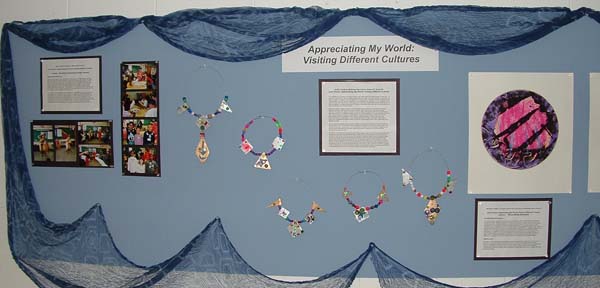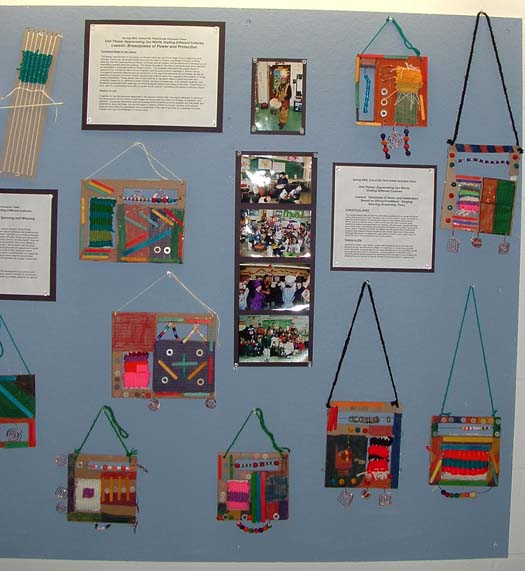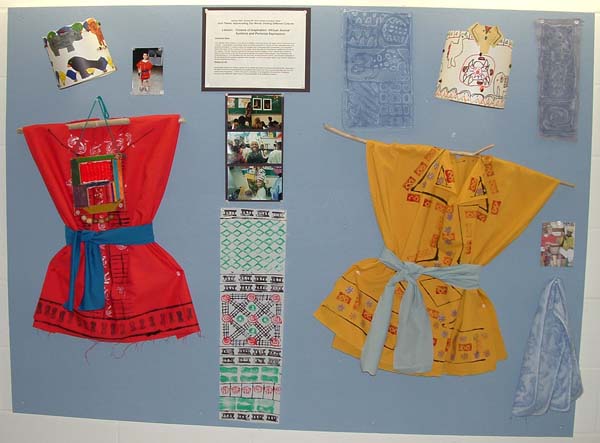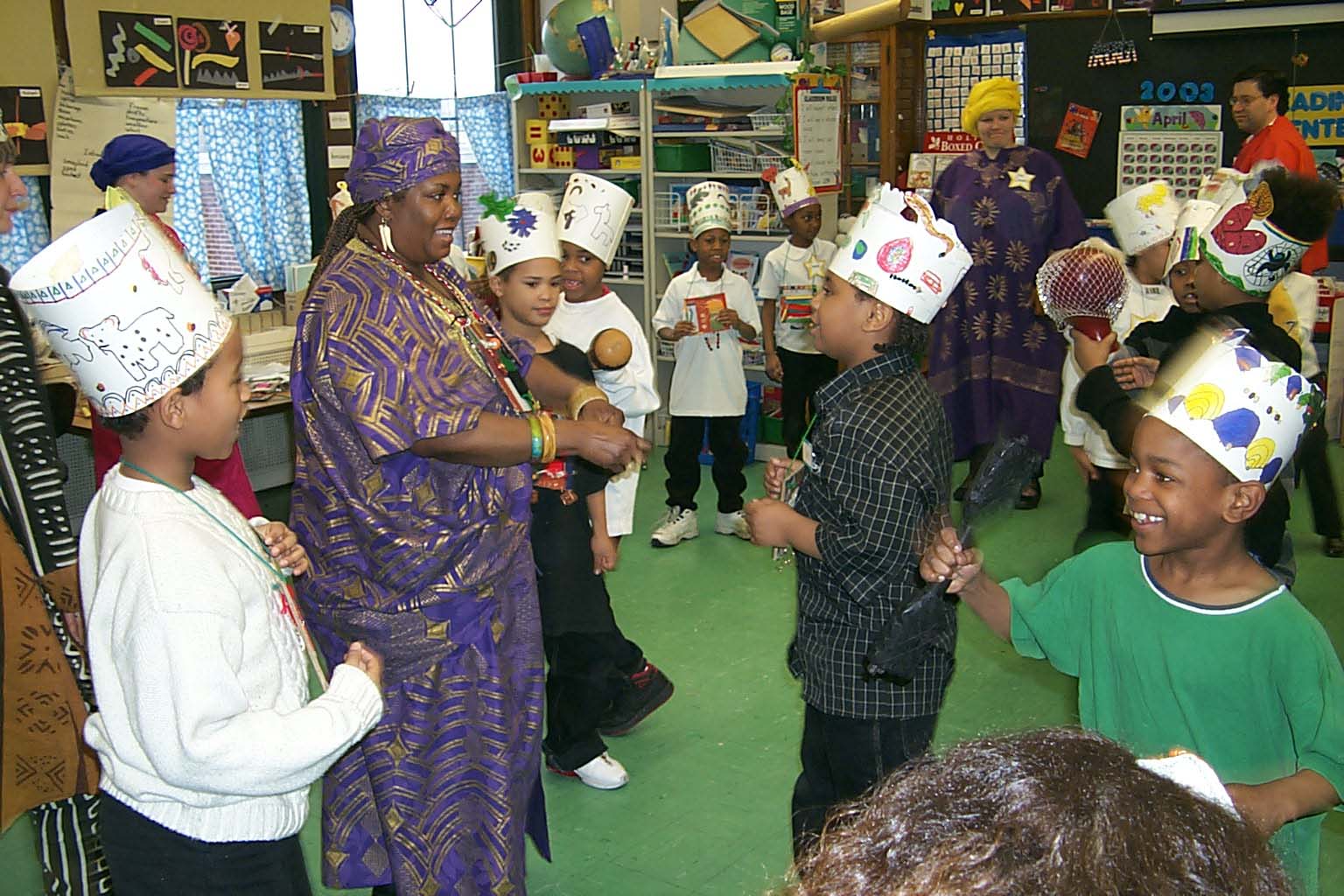Unit Theme: Appreciating My World, Visiting Different Cultures
Author: Lucy Andrus

It is important for all children to become aware of the larger world that exists outside of their own. In addition to enrichment, and for instilling awareness and pride in cultural identity, broadening the students’ view of our global world will enable them to become part of the vital process of working toward understanding and unity through recognition and appreciation for diversity. It is not possible for the citizens of this new millennium to live in peace and productivity without each person attaining such a view and attitude. Increasing awareness of a culture’s aesthetics productions has universal appeal and can aid in the promotion of this process.
Exploring a variety of people, cultures and their art products around the world proved to be an exciting adventure for the Art Partners as we "traveled" to Africa, Asia, Europe and our own North American continent. Through music, dance, drama and visual art, children and teachers alike had the opportunity to learn about the customs, beliefs and artistry of some of our global neighbors. For each introduction to a new culture, every attempt was made to recreate aspects of that culture through such means as examining actual artifacts, listening to authentic music, wearing traditional clothing, sampling foods, and most important, bringing in guest artists and speakers representing each culture we explored. Every lesson begins with a slide/discussion that provides an overview of major aspects of the culture under study, from lifestyles to beliefs.
As we listened to the stories and participated in the life experiences of our guests, we learned something about the lives of our own ancestors, tracing the African, European, North American and Asian roots of the children and teachers. Along the way, we discovered some important things that bring us together as we learned to appreciate difference while also beginning to see and understand more fully the natural connections among all humans.
1. Self-Portraits: Our True Colors
2. Necklaces Inspired by Indian Jewelry
3. Adinkra Symbol Wall Hanging
4. African Textile Design, Finger Spinning and Weaving
5. Breastplates of Power and Protection
6. Crowns of Inspiration African Animal Symbols and Personal Expression
7. Ceremony of Honor and Celebration Based on African Traditions: Singing, Dancing, Drumming, Food
Spring 1998 BUILD Academy, Second Grade Inclusion
Lesson 1: Self-Portraits: Our True Colors

Conceptual Basis of the Lesson
In commencing our journey of learning about getting along with others, we realized that the best place to begin was with us through this self-portrait activity. With a clear understanding that prejudice is a learned behavior that begins when children are just babies, we realized the importance of cultivating understanding and acceptance of our own selves as necessary to our ability to extend this appreciation to others. To learn more about our selves and each other by painting self-portraits, we thought about what it is we immediately notice about someone who is different from ourselves: the color of their skin!
Ideas about skin color can be fraught with stereotypes and emotionally charged perceptions, even for young children. We began to investigate this idea as we looked at our own and each others' actual skin tones. By simply holding black and/or white sheets of paper up to our faces, the children soon realized that some commonly held ideas about skin color are not really true to life. For example, no one is really white and no one is really black and no one is really red and no one is really yellow. It then became very important for us to begin by finding out just what our "true colors" are! Out came the paints and brushes. Lots of curiosity, and a new-found awareness began to blossom as we began to experiment with various pigments, mixing, matching and painting color swatches right on our skin to the satisfaction of our selves and the group. We recorded our newly found colors on a chart (see photograph), and then used them to paint our self-portraits.
What fun it was to discover that some of us are "chocolate", some are "peach", and some are "terra-cotta". And some were combinations like "mocha and olive". Most important, we came closer to understanding how unique each one of is and how exciting it is to have such diversity among us. When we displayed our portraits and the color chart in the school lobby, we noticed many people passing by, young and old alike, stop and hold their arms up to our chart. They were trying to find their own true colors!
Relation to Life
In addition to the obvious benefit of developing respect and appreciation for diversity inherent in such an experience, as well as the opportunity for self-expression through an art process, the students also personally benefited from learning about and sharing a different way to think about things. The exploration of Eastern philosophy provided them with insight into alternative ways to view situations, especially conflictual ones, while the meditative practices helped the children learn another way to manage behavioral responses to stress.
Spring 1999 BUILD Academy, Spring 2000 School 57
Lesson 2: Necklaces Inspired by Indian Jewelry

Conceptual Basis of the Lesson
For this very special day, one of our student teachers, Farrah Ali, who is of Indian ancestry, presented a lesson on the importance of dress and jewelry in Indian society. Dressed in a traditional sari, Miss Farrah taught us about the various ways in which Indian women express themselves through adornment. We learned that the jeweled piece that rests on the forehead is called a tika, and that the dot of color drawn between the eyes is called a bindi. We also learned that certain kinds of jewelry are worn for special occasions like a wedding, where the bride wears an outfit of red and gold with a very elaborate tika. Intricate mehandi designs are also drawn on the hands as a form of personal decoration. It was interesting for the children to make cross-cultural connections as we discussed various forms of body adornment here in the USA, some of which are similar to those found in India.
The Art Partners really enjoyed creating their own neckpieces, complete with "precious metals and jewels". Learning that everyone in India -men, woman, children, rich and poor alike- wears jewelry allowed all to have a wonderful time creating their imaginative designs. To make this session even more exciting, Miss Farrah not only brought in some of her family jewelry for us to see, but she also brought with her guest artist, Miss Priya Venkataraman, a traditional Indian dancer who performed the most beautiful sacred Hindu dances for the Art Partners. We were all enthralled by Miss Priya, from her beautiful clothing and ankle bells to the delicate and graceful movements of fingers, hands, arms and feet. Donning their completed necklaces, the Art Partners enjoyed their own turn at performing traditional dance steps with Miss Priya.
1997 BUILD Academy, 2nd Grade Inclusion Class
Lesson 3: Adinkra Symbol Wall Hanging

Conceptual Basis of the Lesson
Our study of African culture brought us back to the origins of Adinkra symbols and their use by the Ashanti people of Ghana in West Africa. Cloth decorated with Adinkra symbols was originally used to make clothes to be worn only during funeral ceremonies. Adinkra means "goodbye". Today, Adinkra cloth is no longer restricted to periods of grief, but is now a form of dress for many important and diverse occasions.
Adinkra designs are visual symbols that embody the essential meanings of various African proverbs, and are meant to convey history as well as a philosophy for living. Adinkra designs were originally carved into a piece of calabash. Attachment of a split bamboo handle allowed the artist to print the carved design by dipping it into a special dye made from the bark of the badie tree and pressing on cloth in the desired manner. In keeping with African traditions of using materials indigenous to our surroundings to create things, we carved our designs into erasers, used an office stamp pad for our ink source, and printed our designs on readily available school-issue paper towels. The bright colored lines represent the threads used to stitch individual pieces together.
Relation to Life
Learning that all cultures use visual symbols for various reasons helps to bring the world closer together as we discover commonalities within our diversity. In addition, symbol systems are pervasive in many facets of life in today’s world, and developing the ability to read them accurately is an essential competency in the 21st century.
1997 BUILD Academy, 2nd Grade Inclusion Class
Lesson 4: African Textile Design, Finger Spinning and Weaving

Conceptual Basis of the Lesson
For this stop in our journey, attention was specifically given to the cultural ancestry of the African American students in our class as we traveled back to Africa to learn about traditional and contemporary ways of living. We began with a slide overview of the African continent, highlighting its amazing diversity, from climate to lifestyle, settling in West Africa to explore the aesthetics of textile design and production. Questions we discussed: What do different people wear? How is their cloth for clothing made? How are cloth and clothes decorated? How are artmakers involved in textile production? How is this different from the way we do things in the USA, how is it the same? During Part I, the students read the book, Master Weaver of Ghana, introducing the people and textile artisans of this area who specialize in kente cloth. Students also experienced finger spinning using actual cotton bolls so they could see where thread for weaving cloth comes form. In Part II of the lesson, the students completed their own weavings using a simple cardboard loom. Through color choice, weaving designs were meant to symbolically reflect personal qualities students wish to achieve and were to be incorporated into a larger project later on (see Breastplates to the right).
Relation to Life
Awareness and understanding of ancestral heritage contributes to the development of a positive and whole self-identity. The selection of weaving as a focus is deliberately meant to provide an experience that is inherently calming and therapeutic, and through the actual weaving process, students are able to center, focus and sustain attention to task.
Spring 2003, School 68 Third Grade Inclusion Class
Lesson 5: Breastplates of Power and Protection

Conceptual Basis of the Lesson
This lesson was the third in our series on African culture as part of the larger unit on exploring world cultures. Previously, we studied textile arts and how cloth is created, specifically in the art of kente weaving. We also explored the symbolism of African animal imagery and its relevance to developing and expressing positive personal qualities. This lesson focused on the idea of empowerment and protection as expressed in body adornment in African culture. The students viewed and discussed slides of various forms of body art, with a focus on jewelry and its socio-cultural meanings in African culture. Concepts of personal meaning through symbolism in the use of art elements and principles, as well as specific iconography of various African peoples and traditions were then applied to the creation of mixed media breastplates. These pieces used visual symbols to represent ideas of personal power and protection based on our abilities to make choices, develop competencies, and cultivate creativity. The students incorporated their weavings into the breastplate design (see lesson to the left). These were, in turn, used in a culminating ritual with our guest, Emile Latimer, completing this series on African culture.
Relation to Life
In addition to the life relevance described in the previous lesson plan, this lesson attempts to reinforce the development of the children’s self-images as being ones that reflect worthiness, competency and potential. Conscious awareness and acknowledgment of positive personal qualities and the power and potential for acquiring these, are the first steps in helping children to accept, develop and mobilize personal resources and capabilities more purposefully in the task of growing up, especially for those children who may be challenged in various ways.
Spring 2003, School 68 Third Grade Inclusion Class
Lesson 6: Crowns of Inspiration African Animal Symbols and Personal Expression

Conceptual Basis of the Lesson
This was the second lesson in our series on African culture as part of the larger unit on exploring world cultures. The students incorporated ideas of animal symbolism in African art with self-awareness and personal strengths, to create crowns that express their individuality and uniqueness. Our inspiration came from study of the crowns of Yoruba kings, which are one of a kind pieces created exclusively for the wearer. We also learned more about the use of animal imagery in worn objects as a means to assume and convey power As the students learned more about African design, they increased their understanding of how artmakers all over the world, across time and culture, use the same alphabet of art elements and principles to express ideas visually. Look for the oogun ashe in our crowns! (packet of sacred empowering herbs).
Relation to Life
Using ideas inspired by African culture, the students were able to increase self-awareness, especially in the area of personal characteristics and qualities that make them the unique beings they are, and this needs to be recognized. Further, the use of symbolism encourages the development of abstract thinking, and reinforces higher order thinking applicable to all academic subjects.
Spring 2003, School 68 Third Grade Inclusion Class
Lesson 7: Ceremony of Honor and Celebration Based on African Traditions: Singing, Dancing, Drumming, Food

Conceptual Basis of the Lesson
This special session was actually the culminating experience of our series on African culture that is part of our larger semester unit on world cultures. Today, the students used the African-inspired art objects they made and the traditions discovered in African culture to express ideas of affirming the self and ones’ potentials while celebrating freedom and appreciation for diversity. We discussed, danced and sang about these ideas and feelings accompanied by the African drumming of guest artist, Emile Latimer. Following our ritual, the children had the opportunity to taste foods prepared from authentic African recipes as part of their experience of this culture. We began the session by adding the oogun ashe pouches to each child’s crown in a symbolic ritual of empowerment (see Crowns lesson).

Relation to Life
See previous plans. Also, today’s session will emphasize that we are free to be whoever we are, and that we are obliged –to ourselves, our loved ones, and the world citizenship- to be the best we can be by developing our own potentials as well as recognizing each other's uniqueness. Coming together to celebrate such a common purpose allows everyone to experience the universality of and necessity for people to become the kind of citizens needed to live productively in a global world.
This is a non-commercial website and is to be used for educational or research purposes only. No commercial use is permitted without the consent of Art Partners. "Fair use" is claimed under U.S. copyright law, sections 107 and 108. For questions contact:Art Partners
©2002 Art Partners Program | All Rights Reserved